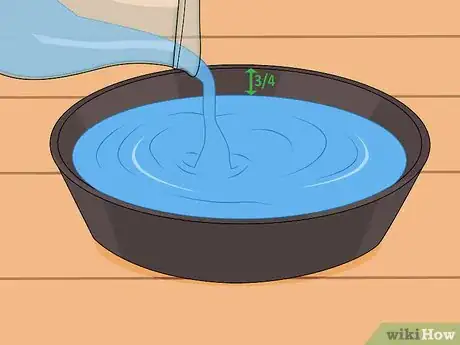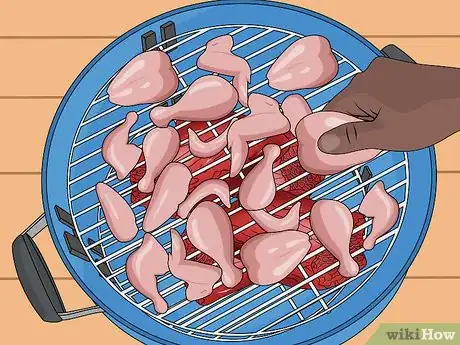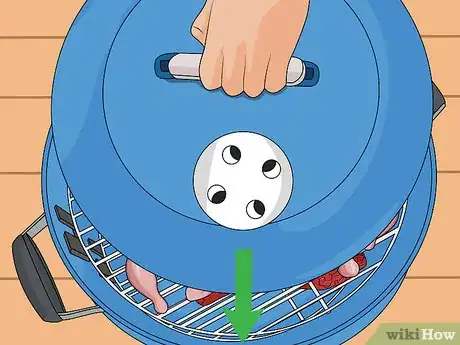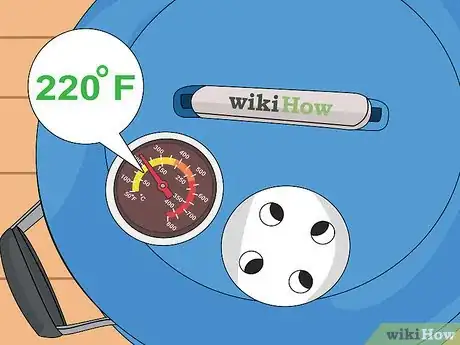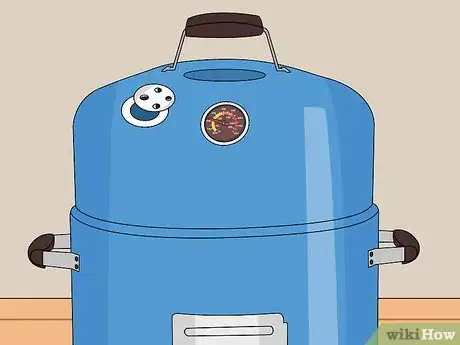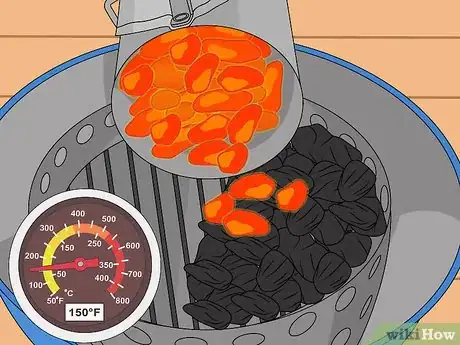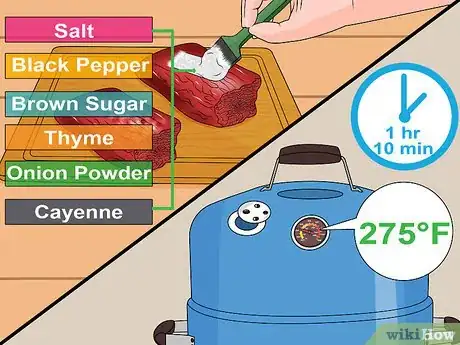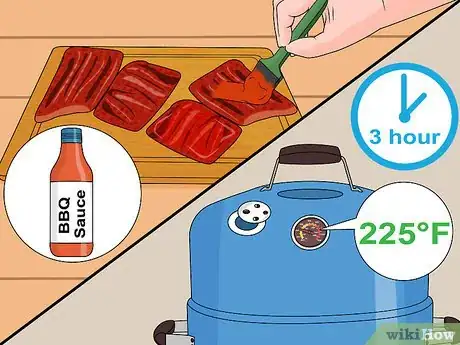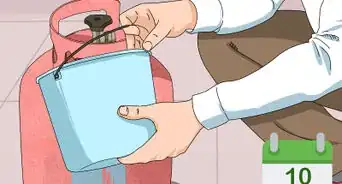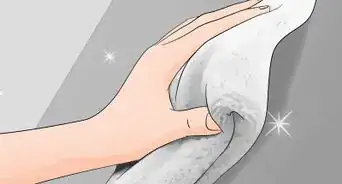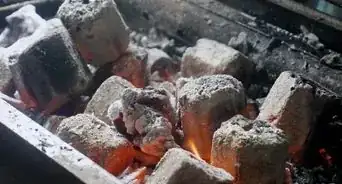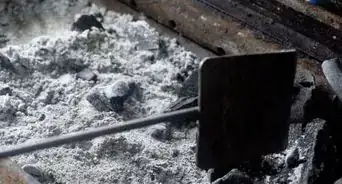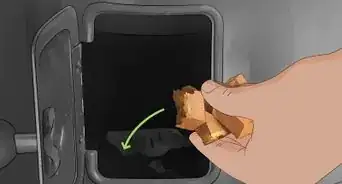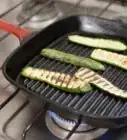This article was co-authored by wikiHow Staff. Our trained team of editors and researchers validate articles for accuracy and comprehensiveness. wikiHow's Content Management Team carefully monitors the work from our editorial staff to ensure that each article is backed by trusted research and meets our high quality standards.
There are 11 references cited in this article, which can be found at the bottom of the page.
wikiHow marks an article as reader-approved once it receives enough positive feedback. In this case, 91% of readers who voted found the article helpful, earning it our reader-approved status.
This article has been viewed 331,272 times.
Learn more...
A charcoal smoker is a great way to cook tender, delicious meat that is full of flavor. Smoking is a little different from grilling in that the goal is to cook the meat with indirect heat. The way you set up the charcoal is important, as well as adding water to keep the meat moist. Making adjustments as the meat cooks ensures the temperature of the smoker stays in the sweet spot, which is about 220℉ (104℃) and no higher than 250℉ (121℃).
Steps
Creating the Smoking Environment
-
1Heat the charcoal in a chimney first. A charcoal chimney is a metal cylinder which is used to get charcoal burning before adding it to a grill or smoker. Visit your local hardware store or look for a chimney online. Add the charcoal to the chimney and light it. Let it sit for about 15 minutes.[1]
- The chimney will have its own instructions which you can follow to make sure the charcoal is lit properly.
- If you don’t want to invest in a charcoal chimney, it’s still important to heat the charcoal up in the smoker before you add the meat.
-
2Add the hot charcoal to the smoker. On one side of the smoker, make a pile of unlit charcoal chunks. Slowly pour the hot charcoal on top of the unlit charcoal. It’s important to set the charcoal up on one side of the smoker and then put the meat on the other side.[2]
- Arranging your coals on one side and the meat on the other side of the smoker allows the meat to cook with indirect heat and smoke rather than with direct heat.
- Other options include setting piles of charcoal on both sides of the smoker and placing the meat in between them or making a circle of charcoal around the outside with meat in the middle.
Advertisement -
3Enhance the smoke with wood chunks. Wood chunks and chips are used to give meat greater flavor. Chunks work better because they smolder for longer. Oak, apple, cherry and hickory woods are often used in smokers. Place the wood in the chimney with the charcoal, but set it off to the side of the charcoal when you add it to the smoker.[3]
- Other woods can be used, but stick to hardwoods. Softwoods create a sooty smoke and will ruin the flavor of your meat.
-
4Fill the water pan 3/4 full with cold water. Smokers have a water pan included, but grills generally do not. Use a foil baking pan if you don’t have a water pan. The water pan sits in the center section of the smoker, or on the grate opposite the meat in a grill.[4]
- Without the water pan, you won't get as much vapor, which helps to evenly cook your meat and vegetables.
- Cold water is helpful to offset the initially higher temperature of the grill. The water helps regulate the temperature down to where you want it for the best smoking.
-
5Place the food on the grate. If your smoker has more than one grate, put the smaller items and vegetables on the top grate. The top grate gets less heat than the lower one. Distribute the larger pieces of meat on the bottom or lower grate.
-
6Set the lid on the smoker so the vents are positioned above the meat. You’re creating a flow of air through the smoker, so you want the vent to be right over the meat. By doing this, you set it up so the smoke is pulled through the smoker, and it wafts right over the meat before it exits.
Maintaining a Quality Smoke
-
1Open the bottom and top vents. Your smoker should have a lower vent, which lets air into the chamber, and a lid vent, which lets the smoker out. Regulate the temperature with the lower vent, depending on the what the smoker needs. If the fire is dying, open the lower vent more. If the temperature is getting too high, close it a little.[5]
- Generally, the top (exhaust) vent should be left open the whole time. Only close it if adjusting the bottom vent does not change the temp the way you need it to.
-
2Keep the temperature of the smoker steady. The ideal smoker temperature is about 220℉ (104℃), but don’t let it exceed 250℉ (121℃). You can increase the temperature by adding new coals to the charcoal pile. Reduce the temperature, if necessary, by closing the lower vent a little. This allows less oxygen to enter the smoker.[6]
- If your smoker doesn’t have a temperature gauge, stick the probe of an oven thermometer through a hole in the lid vent.
-
3Leave the lid on the smoker. Every time you take the lid off, smoke and heat escape. The best meat comes from a smoker with an even, consistent temperature. Only take the lid off if you need to add charcoal or add water to the water pan.[7]
- It’s okay to check on the meat to see how it is cooking and make sure there’s enough coals, but only do this once an hour or so. Smoking is a slow and steady process.
- Smoking is a fairly hands off process, so rest assured that the meat is cooking without you checking it all the time.
-
4Keep a second set of live coals going and add them as necessary. If the temperature inside the smoker is starting to cool, and adjusting the lower vent doesn’t help, add more coals. It is helpful to keep an extra set of coals hot in the chimney in case you need to add them to the smoker.[8]
- This works better than adding unlit charcoal on top of the spent coals.
- If you don’t have a chimney, use a foil baking pan to keep some extra coals hot.
Experimenting with Your Smoker
-
1Cook most meats for about 4 hours at 220°F (104°C). Smoking is not an exact science. The amount of meat you’re cooking, the type of meat, and other factors affect the time it will take to get the perfect cook. Longer times at lower temperatures generally makes the meat more tender.[9]
- There is a point where you've smoked meat for too long. If it cooks so long that it becomes tough all the way through, you'll realize you've cooked it for too long.
-
2Smoke seasoned barbecue pork chops. Rub some pork chops with salt, black pepper, brown sugar, thyme, onion powder and cayenne. Let them soak in the spices for a few hours. Then, with your smoker heated to about 275°F (135°C), smoke the chops for 1 hour and ten minutes.[10]
- Intensify the flavor by adding applewood chips to the coals while you smoke the meat.
- Smother the pork chops in barbecue sauce before you serve them.
-
3Make beer can chicken. Use a whole, raw chicken and smoke it with an open can of beer or soda inserted opening first into the chicken. Stand the chicken upright so the beer moistens it but doesn't spill. Smoke the chicken for 1 1/2 to 3 hours, depending on how much time you have.[11]
- Add other seasonings like garlic, peppercorn, and lime juice to the can of beer.
- Be sure to set the chicken to the side of the live coals, rather than directly over them.
-
4Smoke simple BBQ ribs. Choose St. Louis cut spare ribs. Marinate the ribs in your favorite BBQ sauce. Smoke the ribs for about 3 hours at 225°F (107°C). Then wrap the ribs in foil and smoke them for another 2 hours. Unwrap the ribs and smoke for 1 more hour for delicious, pull-apart ribs.[12]
Community Q&A
-
QuestionCan I put the wood chunks or chips in a different pan?
 Community AnswerI don't soak mine, as it tends to dampen the fire. Instead, I wrap my wood chips in tin foil with small holes in it and place this directly on the coals. This keeps them from burning and allows the fire to get hotter.
Community AnswerI don't soak mine, as it tends to dampen the fire. Instead, I wrap my wood chips in tin foil with small holes in it and place this directly on the coals. This keeps them from burning and allows the fire to get hotter. -
QuestionShould the wood chips be wet or dry?
 Community AnswerSoak them for 30 minutes, then drain. Dry chips or chunks are more likely to burst into flames and make temperatures soar.
Community AnswerSoak them for 30 minutes, then drain. Dry chips or chunks are more likely to burst into flames and make temperatures soar. -
QuestionCan you tell me how to print this page?
 Community AnswerSimply press Ctrl and the letter P (Ctrl+P). You can use this short cut in any portal that has printable content.
Community AnswerSimply press Ctrl and the letter P (Ctrl+P). You can use this short cut in any portal that has printable content.
References
- ↑ https://www.weber.com/US/en/blog/how-to-use-a-chimney-starter
- ↑ http://www.bonappetit.com/test-kitchen/how-to/article/beginners-barbecue
- ↑ http://www.seriouseats.com/2010/04/cooking-out-how-to-grill-barbecue-or-smoke-meat-with-wood-chips-chunks-and-logs.html
- ↑ https://www.kingsford.com/how-to/smoking/#AibvL8Bo3MxCPudq.97
- ↑ http://amazingribs.com/tips_and_technique/controlling_temperature_with_vents.html
- ↑ http://barbecuebible.com/2014/09/09/guide-charcoal-water-smokers/
- ↑ https://www.weber.com/US/en/blog/top-ten-tips-for-smoking
- ↑ https://www.kingsford.com/how-to/smoking/#jMq6yFhjkAwgowBW.97
- ↑ http://www.bonappetit.com/test-kitchen/how-to/article/beginners-barbecue
About This Article
To use a charcoal smoker, start by heating charcoal in a chimney for 15 minutes. Once the charcoal is hot, add it to a pile of unheated coals in the smoker. Keep the coals contained to one side by surrounding it with wood chips like oak or apple, which will cook the meat with indirect heat and smoke. Then, fill the water pan ¾ full with cold water and place it in the center of the smoker or on the side opposite the meat. Next, set the meat on the grates and cover the smoker with a lid, making sure the vents sit over the side the meat is on. To learn how to maintain a quality smoke by ventilating your smoker, read on!



